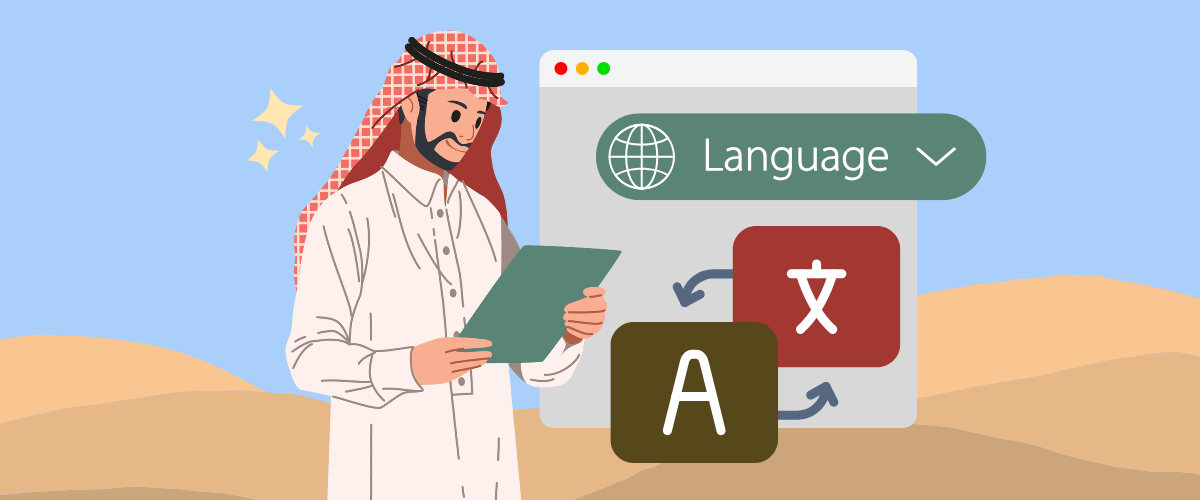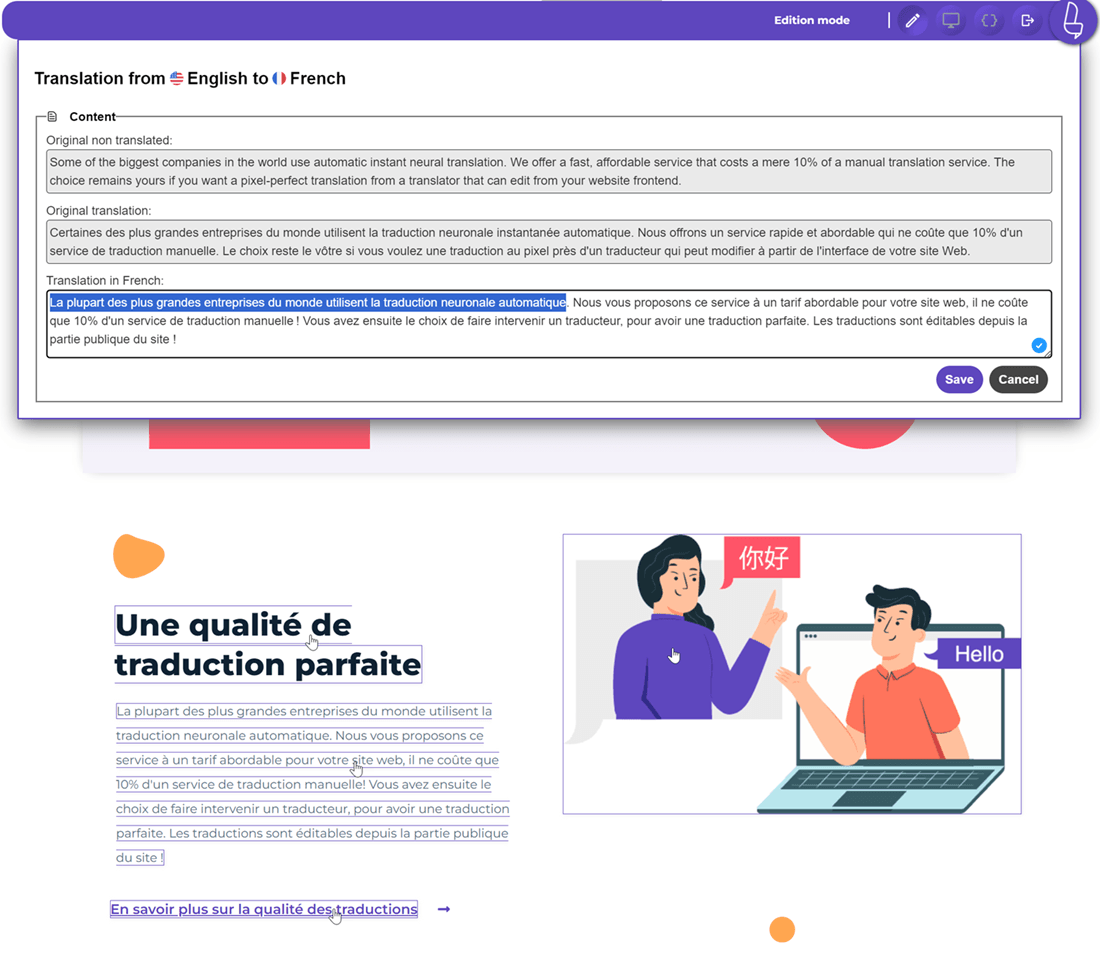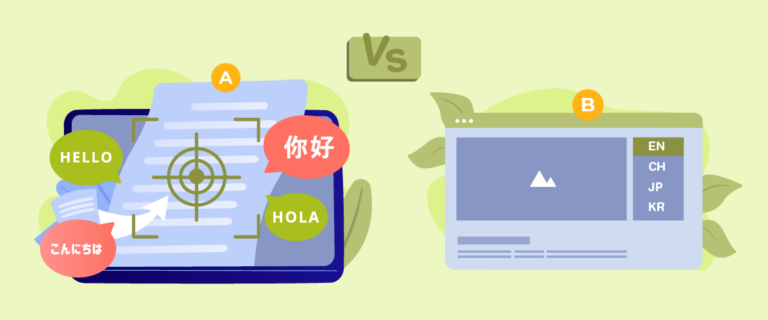Have you ever encountered problems when translating into Arabic? As one of the most complex languages in the world, it’s not uncommon to encounter challenges, whether it’s an incorrect structure or a lack of context.
However, with over 400+ million Arabic speakers worldwide, Arabic plays an important role in global communication, whether for business, education or diplomacy. Therefore, it is important to ensure that translation into Arabic is done well. So, what problems often arise in Arabic translation, and what are the strategies and ways to overcome them? Check out the explanation in this article!
Common translation problems translation into Arabic
Translating into Arabic involves a deep understanding of the language structure, culture and local context. Here are some common challenges in Arabic translation that are often encountered.
Structural and grammatical differences

Arabic has a significantly different sentence structure than English. In Arabic, the verb often comes before the subject. For example, in English, we say “The boy wrote a letter”, but in Arabic it becomes “كتب الولد رسالة”.
In addition, Arabic has a strong gender system. Nouns, adjectives, and verbs must correspond to the gender of the subject or object. For example, the verb “to write” for males is “كتب” (kataba), but for females it becomes “كتبت” (katabat). Mistakes in matching gender can change the meaning of the sentence and confuse. Therefore, translators need to understand this rule to ensure accurate results.
Dialect variations
Arabic has many dialects that vary by region, such as the Egyptian, Gulf, Levant and Modern Standard Arabic (MSA) dialects. While the MSA dialect is used formally in news and official documents, local dialects are more commonly used in everyday conversation.
For example, in the Egyptian dialect, the word “car” is called “عربية” (arabeya), while in the Gulf dialect it is called “سيارة” (sayyara). Most global companies choose Modern Standard Arabic (MSA) for efficiency reasons, but its use is more suitable for formal documents such as user manuals or contracts. In marketing contexts, such as advertising in Saudi Arabia, the use of MSA is often criticized for feeling stilted and culturally irrelevant. As a solution, Netflix managed to customize its translations by using local dialects, making them more acceptable to its audience.
Right-to-Left (RTL) script issues
Arabic is written from right to left (RTL), which often poses technical challenges. In website design, elements such as text, navigation menus, and icons must be adjusted to match the writing direction. For example, the “Next” button, which is usually on the right in English, must be moved to the left in an RTL layout.
Other problems arise in software that does not properly support RTL. For example, if Arabic text is mixed with English numbers or terms, the display order often has errors. To solve this, developers need to use RTL-compatible tools and test the design thoroughly.
Typography and font issues
The next common problem comes from Arabic typography and fonts. You need to know that Arabic letters are connected in cursive, so a font that supports the shape of the letters well is required. For example, the letter “ب” (ba) will look different when standing alone than when it is at the beginning, middle, or end of a word. Using fonts that don’t support this cursive can make the text look unprofessional or difficult to read.
In addition, Arabic text tends to be longer than English text. For example, “Welcome” translates to “مرحبًا بكم” (marhaban bikum), which takes up more space. This can ruin the design layout if not planned well. The solution is to choose a flexible font like “Noto Naskh Arabic” and ensure the design is able to adjust the length of the text.
Religious sensitivities

As we know, Religion plays a very important role in the lives of Arabs, so translators need to be careful with potentially sensitive content. For example, depicting pork or alcohol in advertisements can be considered offensive in most Arab countries, as it goes against Islamic values.
In addition, certain symbols or images that may not be appropriate to the local culture are not recommended. In these cases, translators should avoid such content or replace it with more relevant elements, such as replacing images of food containing pork with beef or chicken.
Idiomatic expressions and figurative language
Arabic is rich in idiomatic expressions and figurative language. For example, the idiom “فوق السحاب” (fawq as-sahab) literally means “above the clouds,” but is used to describe great happiness. If translated literally, this idiom may lose its meaning for foreign readers.
Another example is the expression “يد واحدة لا تصفق” (yad wahida la tusaffiq), which means “one hand cannot clap.” This expression actually shows the importance of cooperation, but the literal translation may sound strange. In this situation, the translator needs to find a local equivalent that has a similar meaning, such as “teamwork makes the dream work.”
Those are some common problems that are often found when content is translated into Arabic. So how can you overcome these problems? We will discuss it below.
Strategies and best practices for Arabic translation
Addressing the challenges of translating into Arabic requires a strategic approach and best practices tailored to the characteristics of the Arabic language and culture. The following are steps that can be taken to ensure an accurate, effective and relevant translation process.
Understanding of Arabic grammar and syntax

The first step is to understand Arabic grammar and syntax. Arabic has a different sentence structure, often putting the verb before the subject. For example, the English sentence “The teacher explains the lesson” translates to “يشرح المعلم الدرس” (yashrah al-mu’allim ad-dars), where the verb “yashrah” (to explain) comes first.
Here is a table of Arabic grammar rules and examples that you can understand first.
Rule | Example in Arabic | Transliteration | English Translation |
Verb-Subject-Object Order | يشرح المعلم الدرس | yashrah al-mu’allim ad-dars | The teacher explains the lesson |
Adjective Agreement (Masculine) | الطالب يقرأ الكتاب | al-talib yaqra’ al-kitab | The student reads the book |
Adjective Agreement (Masculine) | طالب ذكي | talib dhaki | A smart male student |
Adjective Agreement (Feminine) | طالبة ذكية | talibah dhakiyah | A smart female student |
Dual Form (Subject) | الطالبان يقرآن الكتاب | al-taliban yaqra’an al-kitab | The two students read the book |
Plural Form (Subject) | الطلاب يقرؤون الكتاب | al-tullab yaqra’un al-kitab | The students read the book |
Definite Article (“the”) | الكتاب | al-kitab | The book |
Indefinite Noun (no “the”) | كتاب | kitab | A book |
Possessive Structure (of) | كتاب المعلم | kitab al-mu’allim | The teacher’s book |
Negation (Verb) | لا يشرح المعلم الدرس | la yashrah al-mu’allim ad-dars | The teacher does not explain the lesson |
Cultural immersion
An in-depth knowledge of Arabic culture goes a long way in producing relevant and acceptable translations. Arabic culture is rich in traditions and values that influence the way they understand communication. For example, the use of idiomatic expressions such as “يد واحدة لا تصفق” (yad wahida la tusaffiq), meaning “cooperation is important” can be used to convey a more contextualized meaning in translation.
In addition understanding cultural sensitivities is also important to avoid content that could be considered disrespectful. For example, replacing images of pork-containing foods with chicken-based dishes in promotional materials would be more appropriate for an Arabic audience.
Pay attention to the target audience: local dialect or MSA
Next, understand your intended audience, whether they use local dialects or Modern. MSA (Modern Standard Arabic) is often used for formal documents such as user manuals or contracts, as it is neutral and widely understood. However, for social media campaigns or local advertising, local dialects such as Egyptian or Gulf Arabic are more effective as they feel more personalized and relevant to the audience.
For example, Netflix uses MSA in most of its content to reach audiences across the Arab region. However, for a specific campaign in Egypt, they added elements of the Egyptian dialect to make it feel more familiar, which helped increase user engagement.
Be culturally sensitive
Arab culture has certain restrictions, such as prohibitions against content that promotes alcohol, gambling, or language that is considered abusive. Therefore, translators have to be very careful with the choice of words and images.
For example, in a global marketing campaign, Coca-Cola replaced an ad featuring a nighttime party with a scene of a family breaking their fast during Ramadan. This adjustment reflected respect for the cultural and religious values of the target audience.
Pay attention to website layout and format

Arabic uses a Right-to-Left (RTL) layout, which can affect the design of websites and documents. Elements such as navigation buttons, menus, and text must be adjusted to appear intuitively to Arabic readers.
For example, the “Next” button, which is usually on the right in English, should be moved to the left in RTL design. Fonts such as “Noto Naskh Arabic” can also ensure that Arabic letters are displayed clearly and professionally.
Using the right translation tools

For accurate yet efficient Arabic translation, consider using a translation tool that supports Arabic and RTL layout. Many tools are available today, such as the Linguise automatic translation website.
It is one of the reliable tools for Arabic translation, as it uses AI to produce translations that are up to 97% accurate and localized. Linguise also allows adaptation of the text according to dialect and cultural context, making it more relevant to local audiences.
Collaborative with native speakers
Aside from using translation tools, you can also combine this with working with native speakers to ensure the translation feels natural. Native speakers have insights into idioms, colloquial expressions and local culture that non-native translators cannot fully understand.
For example, when translating an educational website, working with a local teacher can help craft sentences that match the language used in the classroom, making it more effective in delivering the material.
In addition, translation tools like Linguise also allow you to collaborate and invite external translators. Since they have a collaboration feature on the dashboard, how exciting is that?
Review and edit the translation to ensure accuracy

The editing and review process is the last step that should not be missed. Even the best translations can have small errors that can affect comprehension or user experience.
Therefore, if you are using an automatic translation tool, you should still review the machine translation. However, you don’t worry; translation tools are now more sophisticated, such as Linguise, which not only has collaboration features but also a front-end editor that allows you to edit directly on the site’s front page by directly selecting which part of the content.
Conclusion
Translating into Arabic can be a huge challenge, mainly due to the complex structure of the language and the variety of dialects spoken in different regions. Not only that, cultural factors and religious sensitivities must also be taken into consideration to keep the translation relevant and not offensive to the audience.
In order to overcome the problems in translating to Arabic, it is important to understand the grammar, be familiar with the local culture, and use a translation tool that can handle the differences. One of the best solutions to help you is Linguise, which offers accurate automatic translation with the ability to customize translation results and cultural context. Try a 1-month Linguise account to see how it can help make your Arabic translation process more accurate and relevant!





